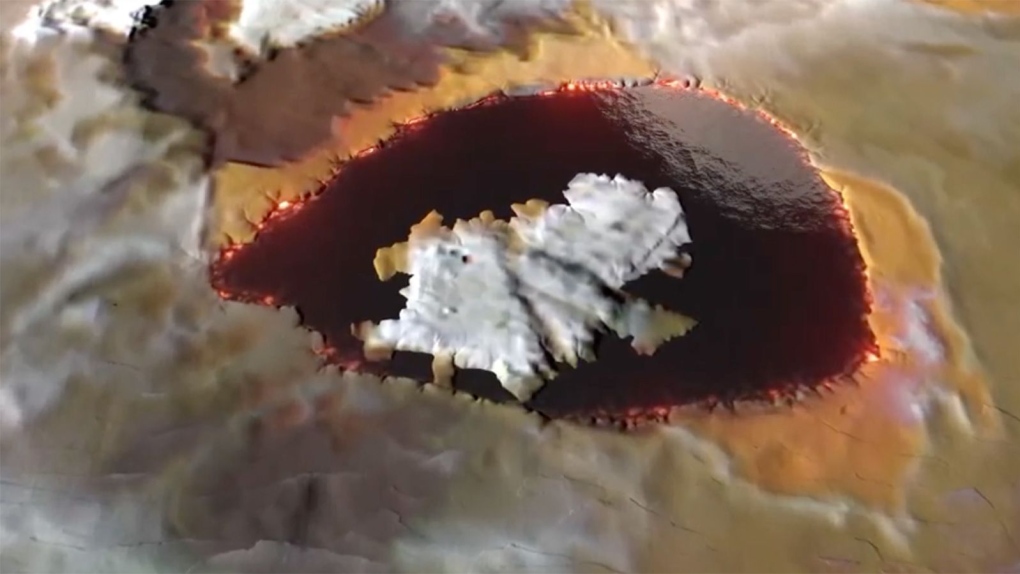Close flybys of Io, one of Jupiter’s moons and the most volcanically active world in our solar system, have revealed a lava lake and a towering feature called "Steeple Mountain" on the moon’s alien surface.
NASA’s Juno spacecraft, which first arrived to study Jupiter and its moons in 2016, flew within roughly 930 miles (1,500 kilometres) of the lava world’s surface in December and February to capture the first detailed images of Io’s northern latitudes.
It has been more than 20 years since a mission flew so closely by Io, and the spacecraft’s camera, called JunoCam, captured high-resolution images that showcased active volcanic plumes, mountain peaks and a glass-smooth lake of cooling lava.
"Io is simply littered with volcanoes, and we caught a few of them in action," said Scott Bolton, Juno’s principal investigator at the Southwest Research Institute, in a statement.
"We also got some great close-ups and other data on a 200-kilometre-long (127-mile-long) lava lake called Loki Patera. There is amazing detail showing these crazy islands embedded in the middle of a potentially magma lake rimmed with hot lava," he added. "The specular reflection our instruments recorded of the lake suggests parts of Io’s surface are as smooth as glass, reminiscent of volcanically created obsidian glass on Earth."
Bolton announced the findings on April 16 at the European Geophysical Union General Assembly in Vienna. The new data is painting a clearer portrait of Io, which has intrigued scientists for centuries.
"Other than the Earth, it’s the only place that we see active magma volcanoes going on in our solar system," Bolton said.
Animating an alien world
The team translated portions of Juno’s data into animations that bring some of the hellish world’s surface features, such as Loki Patera and Steeple Mountain, into dramatic focus.
Juno detected the mountain with the help of the sun shining on Io’s surface, which created dramatic shadows that revealed a very sharp peak.
“We used the scientific data to understand the shadows and measure the distance,” Bolton said. “It may not be perfectly right, but this is sort of what it would be like if you went there. We call this Steeple Mountain, because it’s so steep there at the edge, it may be Io’s version of the Matterhorn.”
Although the temperature of the magma on Io amounts to thousands of degrees, the surface of the moon is likely minus 148 degrees Fahrenheit (minus 100 degrees Celsius), Bolton said.
"When the magma comes out as a volcano goes off, it immediately freezes and probably makes sulfur snow," he said.
As an outdoors enthusiast, Bolton joked that Io’s Steeple Mountain should be one of the solar system’s skiing and snowboarding destinations.
Meanwhile, Loki Patera is another spot with hot and cold extremes. While the lava lake itself is likely very hot, the top of the islands are probably very cold, and a cold crust may rim the edges of the lake as well, Bolton said.
The mission team used Juno’s Microwave Radiometer instrument to create maps of Io’s surface, showing how incredibly smooth it is.
The topography lacks contours because Io is so volcanically active that the world is constantly resurfaced by lava, which erases impact craters from its surface, according to a new study from a separate research team published in the journal Science on April 18.
The team also used the Atacama Large Millimetre/submillimetre Array of telescopes in Chile to observe gases in Io’s atmosphere. The researchers found evidence of an abundance of enriched sulfur and chlorine, which suggests that Io has likely been volcanically active and releasing the gases for most or all of its history over the past 4 billion years.
Revealing Io’s mysteries
Io, first discovered by Galileo Galilei in 1610, is just slightly larger than our moon, but it’s unlike anywhere else in the solar system.
The rocky moon’s surface is covered with hundreds of volcanoes, drawing comparisons to the fictional volcanic planet Mustafar and its rivers of lava from the "Star Wars" films.
Scientists have observed Io’s powerful volcanoes spewing lava fountains that are dozens of miles high and can even be seen with large telescopes on Earth, according to NASA.
The moon’s name came from a Greek myth in which a mortal woman is turned into a cow during a marital dispute between the god Zeus and his wife Hera. The moniker is a fitting one, because Io is in a constant state of tug-of-war, pulled by the massive gravity of Jupiter, as well as its large moons Europa and Ganymede.
These three worlds tug so violently on Io that its surface bulges in and out by 330 feet (100 metres), like high and low tides on Earth — but it’s happening on solid ground, rather than in an ocean. Bolton said he often refers to Io as “Jupiter’s tortured moon” because of the ferocious forces it regularly encounters.
The forces exerted on Io by Jupiter, Europa and Ganymede cause Io’s surface to face a tremendous amount of heat, which is why the moon’s subsurface remains like liquid rock. Researchers believe that liquid rock is either made of molten sulfur or silicate rock, and volcanic eruptions help the moon relieve the gravitational pressure.
Io has been studied by multiple spacecraft, including the Pioneer and Voyager probes in the 1970s and the Galileo spacecraft in the 1990s. And now, Juno’s revelations are helping scientists to understand the forces behind the moon’s volcanic activity like never before.








































